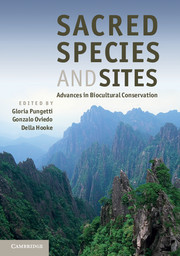Book contents
- Frontmatter
- Contents
- List of Contributors
- Foreword
- Preface
- Acknowledgements
- Introduction
- Part I Concepts and Knowledge
- Part II Sacred Landscapes
- Part III Sacred Sites and People
- Part IV Sacred Species
- 13 The conservation status of sacred species: a preliminary study
- 14 The role of taboos and traditional beliefs in aquatic conservation in Madagascar
- 15 Sacred species of national marine sanctuaries of the United States’ West Coast
- 16 Integrating biocultural values in nature conservation: perceptions of culturally significant sites and species in adaptive management
- Part V Sacred Animals
- Part VI Sacred Groves and Plants
- Part VII Implementation and Conclusions
- Index
- Plate Section
- References
15 - Sacred species of national marine sanctuaries of the United States’ West Coast
from Part IV - Sacred Species
Published online by Cambridge University Press: 05 August 2012
- Frontmatter
- Contents
- List of Contributors
- Foreword
- Preface
- Acknowledgements
- Introduction
- Part I Concepts and Knowledge
- Part II Sacred Landscapes
- Part III Sacred Sites and People
- Part IV Sacred Species
- 13 The conservation status of sacred species: a preliminary study
- 14 The role of taboos and traditional beliefs in aquatic conservation in Madagascar
- 15 Sacred species of national marine sanctuaries of the United States’ West Coast
- 16 Integrating biocultural values in nature conservation: perceptions of culturally significant sites and species in adaptive management
- Part V Sacred Animals
- Part VI Sacred Groves and Plants
- Part VII Implementation and Conclusions
- Index
- Plate Section
- References
Summary
Introduction
In 1972, the United States Congress embarked on a grand programme to designate and protect for future generations the special areas of the United States’ oceans and Great Lakes ecosystems. In passing this landmark legislation in 1972, the Congress debated at length how protective these special areas should be and also what to call them. Ultimately they chose to make resource protection the top priority, but to also promote research, education and multiple use to the extent that human use did not conflict with the mandate for resource protection.
As significantly, these new marine areas, complementary to the much-heralded national parks on land, were called ‘national marine sanctuaries’. While the choice of this term has posed contradictions for many staunch environmentalists as well as advocates for ocean development and extraction, the name ‘sanctuary’ reflects what has been a constant through time in the US – oceans are areas of constant renewal to humans, sacred places to many and a part of our collective national identity essential to the spiritual and economic livelihoods of hundreds of millions of Americans.
There are 13 national marine sanctuaries and 1 marine national monument managed as part of the National Marine Sanctuary System. Of these, five national marine sanctuaries have been designated on the west coast of the US, offshore Washington state (Olympic Coast) and California (Cordell Bank, Gulf of the Farallones, Monterey Bay and Channel Islands; Figure 15.1). Each of these west coast sanctuaries is relatively large, ranging between 550 and 6094 square miles (1408 and 15 601 km2) and has been designated to protect entire ecosystems.
- Type
- Chapter
- Information
- Sacred Species and SitesAdvances in Biocultural Conservation, pp. 219 - 230Publisher: Cambridge University PressPrint publication year: 2012



